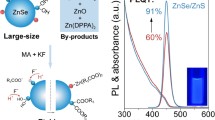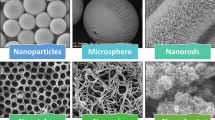Abstract
Three-layer thicknesses (\({T}_{1 }= 50\), \({T}_{2 }= 75\) and \({T}_{3 }= 100\) nm) of 1,2-bis(diphenylphosphino)ethyl tungsten tetracarbonyl methyl red (DPE-W-MR) were deposited onto the CuO thin film (50 nm) to produce DPE-W-MR/CuO di-layer thin films by sol–gel spin-coating technique. The composition and the chemical structure of the as-prepared thin films were characterized using various techniques including elemental analysis, Fourier transform infrared spectroscopy, \(^{1}\hbox {H}\)-NMR and X-ray diffraction (XRD). Scanning electron microscopy was used to investigate the size and shape of the CuO nanoparticles and the fabricated thin films. The films are crystalline as evidenced by the XRD pattern and DPE-W-MR has an orthorhombic crystal system. The crystallite size was calculated from an analysis of the line broadening features using the Scherrer formula; the average crystallite sizes of DPE-W-MR/CuO di-layer thin films are 52.92, 56.24 and 72.26 nm for \({T}_{1}\), \({T}_{2}\) and \({T}_{3}\), respectively. Thermogravimetric analysis and the thermal curve of DPE-W-MR complex were studied. Optical properties of DPE-W-MR/CuO di-layer thin films are discussed. The optical band gap energies of DPE-W-MR di-layer thin films/CuO decreased (2.25, 2.1 and 1.88 eV) as the film thickness increased (from \({T}_{1}\) to \({T}_{3})\). Based on the optical results and the quantum confinement effects, the DPE-W-MR/CuO di-layer thin films may be candidates as semiconductor materials for optoelectronic devices.










Similar content being viewed by others
References
Liu Z, Liu G, Liu X, Huang S, Liu M, Fu Guolan et al 2015 Mater. Lett. 139 12
Hosny N M, Samir G, Zoromba M S and Alghool S 2017 J. Polym. Plast. Technnol. Eng. 56 435
Zoromba M S, Bassyouni M and Abdel-Hamid S 2015 Rubber Chem. Technol. 88 449
Zoromba M S, Ismail M I M, Bassyouni M, Abdel-Aziz M H, Numan S, Alshahrie A et al 2017 Coll. Surf. A Phys. Chem. Eng. Asp. 520 121
Al-Hossainy A F 2016 Bull. Mater. Sci. 39 209
Pate J, Zamora F, Watson M D S, Wright G N, Horrocks B and Houlton A 2014 J. Mater. Chem. C 2 9265
Liao Y-C and Kao Z-K 2012 ACS Appl. Mater. Interface 10 5109
Liu T, Vilar R, Eugénio S, Joseph G and Yann D 2015 J. Appl. Electrochem. 45 87
Yang-Kai H, Shih-Pin C, Su C-H and Liao Y-C 2015 Sci. Adv. Mater. 7 227
Volpati D, Spada E R, Plá Cid C C, Sartorelli M L, Aroca R and Constantino C 2015 Analyst 140 476
Yonezawa Y, Takami A and Sato T 1990 J. Appl. Phys. 68 1297
Griffiths M, Pallister P, Mandia D and Barry S 2015 Chem. Mater. 28 44
Hyeong-Chul Y, Jin-Ha S, Park H-S and Su-Jeong S 2015 J. Nanosci. Nanotechnol. 15 1601
Nagai H, Mita S, Takano I, Honda T and Sato M 2015 Mater. Lett. 141 235
Ghotbi M and Rahmati Z 2015 Mater. Des. 85 719
Walker S D, Barder T E, Martinelli J and Buchwald S 2004 Angew. Chem. Int. Ed. 43 1871
Caminade A-M, Maraval V, Laurent R and Majoral J-P 2002 Curr. Org. Chem. 6 739
Iwasawa T, Tokunaga M, Obora Y and Tsuji Y 2004 J. Am. Chem. Soc. 126 6554
Niyomura O, Iwasawa T, Sawada N, Tokunaga M, Obora Y and Tsuji Y 2005 Organometallics 24 3468
Chen J, Law C, Lam J, Dong Y, Lo S, Williams I et al 2003 Chem. Mater. 15 1535
Verma A, Hirsch D, Glatt C, Ronnett G and Snyder S 1993 Sci. Wash. 259 381
Clark J, Naughton P, Shurey S, Green C, Johnson T, Mann B et al 2003 Circ. Res. 93 e2
Awad I, Hassan F, Mohamed A and Al-Hossainy A 2004 J. Phosphorus Sulfur Silicon 179 1251
Hassan F, Al-Hossainy A and Mohamed A 2009 J. Phosphorus Sulfur Silicon 184 2996
Badr M, El-Amin A and Al-Hossainy A 2008 J. Phys. Chem. C 112 14188
Badr M, El-Amin A and Al-Hossainy A 2006 Eur. Phys. J. B 53 439
Takakazu Y, Yoshio E, Minoru K and Akio Y 1980 Bull. Chem. Soc. Jpn. 53 1299
Maury R, Jhamb S, Roy S, Chourasia J, Sharma A and Vishwakarma P 2015 Arab. J. Chem. 8 143
El-Morsy F, Jean-Claude B, Butler I, El-Sayed S and Mostafa S 2014 Inorg. Chim. Acta 423 144
El-Hendawy A M, El-Kourashy A E-G and Shanab M M 1992 Polyhedron 11 523
Santra P, Sinha C, Sheen W-J, Liao F-L and Lu T-H 2001 Polyhedron 20 599
Maurya M, Jayaswal M, Puranik V, Chakrabarti P, Gopinathan S and Gopinathan 1997 Polyhedron 16 3977
Chand P, Gaur A and Kumar A 2013 Superlattices Microstruc. 60 129
Valentini A, Nappi E and Nitti M 2002 Nucl. Instrum. Methods Phys. Res. A 482 238
Myburg G and R Swanepoel 1987 J. Non-Cryst. Solids 89 13
Minkov D 1989 J. Phys. D Appl. Phys. 22 199
Manifacier J, Gasiot J and Fillard J 1976 J. Phys. E Sci. Instrum. 9 1002
Zoromba M, Al-Hossainy A and Abdel-Aziz M 2017 Synth. Met. 231 34
Trilok, Rai R and Singh B K 2015 Nucl. Instrum. Methods Phys. Res. A 785 70
Al-Hossainy A and Ali I 2015 Opt. Mater. 46 131
Al-Hossainy A and Ali I 2015 Mater. Sci. Semicond. Proc. 38 13
Acknowledgements
This study was funded by Faculty of Science, New Valley Branch, Assiut University (AUN) and Northern Border University (NBU), Arar. We, therefore, acknowledge with thanks AUN and NBU financial support.
Author information
Authors and Affiliations
Corresponding author
Rights and permissions
About this article
Cite this article
Al-Hossainy, A.F., Zoromba, M.S. & Hassanien, R. Eco-friendly method to synthesize and characterize 2D nanostructured (1,2-bis(diphenyl-phosphino)ethyl) tungsten tetracarbonyl methyl red/copper oxide di-layer thin films. Bull Mater Sci 41, 80 (2018). https://doi.org/10.1007/s12034-018-1594-2
Received:
Accepted:
Published:
DOI: https://doi.org/10.1007/s12034-018-1594-2




